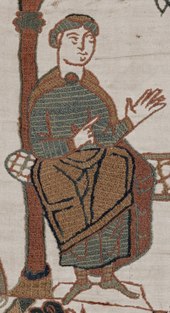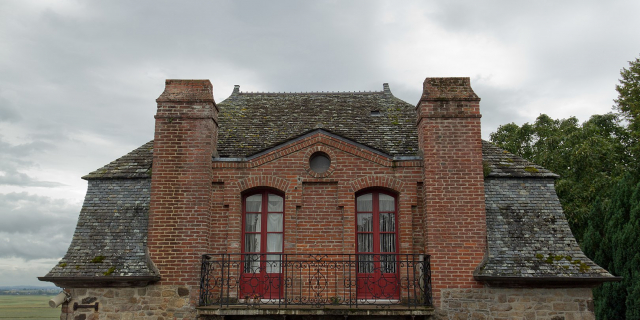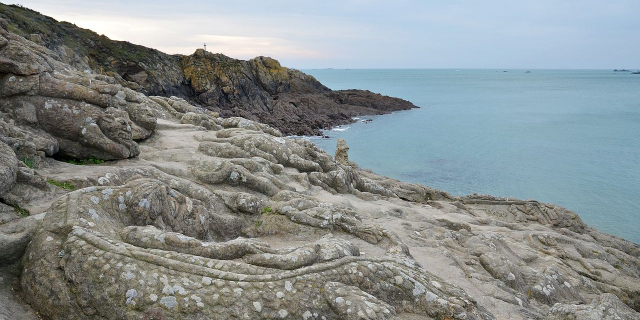Tapisserie de Bayeux
( Bayeux Tapestry )
The Bayeux Tapestry (UK: , US: ; French: Tapisserie de Bayeux [tapisʁi də bajø] or La telle du conquest; Latin: Tapete Baiocense) is an embroidered cloth nearly 70 metres (230 feet) long and 50 centimetres (20 inches) tall that depicts the events leading up to the Norman Conquest of England in 1066, led by William, Duke of Normandy challenging Harold II, King of England, and culminating in the Battle of Hastings. It is thought to date to the 11th century, within a few years of the battle. Now widely accepted to have been made in England perhaps as a gift for William, it tells the story from the point of view of the conquering Normans and for centuries has been preserved in Normandy.
According to Sylvette Lemagnen, conservator of the...Read more
The Bayeux Tapestry (UK: , US: ; French: Tapisserie de Bayeux [tapisʁi də bajø] or La telle du conquest; Latin: Tapete Baiocense) is an embroidered cloth nearly 70 metres (230 feet) long and 50 centimetres (20 inches) tall that depicts the events leading up to the Norman Conquest of England in 1066, led by William, Duke of Normandy challenging Harold II, King of England, and culminating in the Battle of Hastings. It is thought to date to the 11th century, within a few years of the battle. Now widely accepted to have been made in England perhaps as a gift for William, it tells the story from the point of view of the conquering Normans and for centuries has been preserved in Normandy.
According to Sylvette Lemagnen, conservator of the tapestry, in her 2005 book La Tapisserie de Bayeux:
The Bayeux tapestry is one of the supreme achievements of the Norman Romanesque .... Its survival almost intact over nine centuries is little short of miraculous ... Its exceptional length, the harmony and freshness of its colours, its exquisite workmanship, and the genius of its guiding spirit combine to make it endlessly fascinating.
The cloth consists of 58 scenes, many with Latin tituli, embroidered on linen with coloured woollen yarns. It is likely that it was commissioned by Bishop Odo of Bayeux, William's maternal half-brother, and made for him in England in the 1070s. In 1729, the hanging was rediscovered by scholars at a time when it was being displayed annually in Bayeux Cathedral. The tapestry is now exhibited at the Musée de la Tapisserie de Bayeux in Bayeux, Normandy, France (49.2744°N 0.7003°W / 49.2744; -0.7003).
The designs on the Bayeux Tapestry are embroidered rather than in a tapestry weave, so it does not meet narrower definitions of a tapestry. Nevertheless, it has always been referred to as a tapestry until recent years when the name "Bayeux Embroidery" has gained ground among certain art historians. It can be seen as a rare example of secular Romanesque art. Tapestries adorned both churches and wealthy houses in Medieval Western Europe, though at 0.5 by 68.38 m (1 ft 8 in by 224 ft 4 in), the Bayeux Tapestry is exceptionally large. Only the figures and decoration are embroidered, on a background left plain, which shows the subject very clearly and was necessary to cover large areas.
 Bishop Odo of Bayeux
Bishop Odo of BayeuxThe earliest known written reference to the tapestry is a 1476 inventory of Bayeux Cathedral,[1] but its origins have been the subject of much speculation and controversy.
French legend maintained the tapestry was commissioned and created by Queen Matilda, William the Conqueror's wife, and her ladies-in-waiting. Indeed, in France, it is occasionally known as La Tapisserie de la Reine Mathilde ("The Tapestry of Queen Matilda"). However, scholarly analysis in the 20th century concluded it was probably commissioned by William's half-brother, Bishop Odo of Bayeux,[2] who, after the Conquest, also became Earl of Kent and, when William was absent in Normandy, regent of England.
The reasons for the Odo commission theory include:
three of the bishop's followers mentioned in the Domesday Book appear on the tapestry; it was found in Bayeux Cathedral, built by Odo; it may have been commissioned at the same time as the cathedral's construction in the 1070s, possibly completed by 1077 in time for display on the cathedral's dedication.Assuming Odo commissioned the tapestry, it was probably designed and constructed in England by Anglo-Saxon artists (Odo's main power base being by then in Kent); the Latin text contains hints of Anglo-Saxon; other embroideries originate from England at this time; and the vegetable dyes can be found in cloth traditionally woven there.[3][4][5] Howard B. Clarke has proposed that the designer of the tapestry (i.e. the individual responsible for its overall narrative and political argument) was Scolland, the abbot of St Augustine's Abbey in Canterbury, because of his previous position as head of the scriptorium at Mont Saint-Michel (famed for its illumination), his travels to Trajan's Column, and his connections to Wadard and Vital, two individuals identified in the tapestry.[6][7] Alternatively, Christine Grainge has argued that the designer may have been Lanfranc, Archbishop of Canterbury 1070–1089.[8] The actual physical work of stitching was most probably undertaken by female needleworkers. Anglo-Saxon needlework of the more detailed type known as Opus Anglicanum was famous across Europe. It was perhaps commissioned for display in the hall of Odo's palace in Bayeux, and then bequeathed to the cathedral he had built, following the precedent of the documented but lost hanging of the Anglo-Saxon warrior Byrhtnoth, bequeathed by his widow to Ely Abbey.[9]
Other theories exist. Carola Hicks has suggested the tapestry could possibly have been commissioned by Edith of Wessex, widow of Edward the Confessor and sister of Harold.[10] Wolfgang Grape has challenged the consensus that the embroidery is Anglo-Saxon, distinguishing between Anglo-Saxon and other Northern European techniques;[11] Medieval material authority Elizabeth Coatsworth[12] contradicted this: "The attempt to distinguish Anglo-Saxon from other Northern European embroideries before 1100 on the grounds of technique cannot be upheld on the basis of present knowledge."[5] George Beech suggests the tapestry was executed at the Abbey of Saint-Florent de Saumur in the Loire Valley and says the detailed depiction of the Breton campaign argues for additional sources in France.[13] Andrew Bridgeford has suggested that the tapestry was actually of English design and encoded with secret messages meant to undermine Norman rule.[14]
Recorded historyThe first reference to the tapestry is from 1476 when it was listed in an inventory of the treasures of Bayeux Cathedral. It survived the sack of Bayeux by the Huguenots in 1562; and the next certain reference is from 1724.[15] Antoine Lancelot sent a report to the Académie Royale des Inscriptions et Belles-Lettres concerning a sketch he had received about a work concerning William the Conqueror. He had no idea where or what the original was, although he suggested it could have been a tapestry.[16] Despite further enquiries he discovered no more.
 Montfaucon / Benoît drawing showing King Harold's death
Montfaucon / Benoît drawing showing King Harold's deathThe Benedictine scholar Bernard de Montfaucon made more successful investigations and found that the sketch was of a small portion of a tapestry preserved at Bayeux Cathedral. In 1729 and 1730 he published drawings and a detailed description of the complete work in the first two volumes of his Les Monuments de la Monarchie française. The drawings were by Antoine Benoît, one of the ablest draughtsmen of that time.[16]
The tapestry was first briefly noted in English in 1746 by William Stukeley, in his Palaeographia Britannica.[17] The first detailed account in English was written by Smart Lethieullier, who was living in Paris in 1732–3, and was acquainted with Lancelot and de Montfaucon: it was not published, however, until 1767, as an appendix to Andrew Ducarel's Anglo-Norman Antiquities.[16][18][19]
During the French Revolution, in 1792, the tapestry was confiscated as public property to be used for covering military wagons.[15] It was rescued from a wagon by a local lawyer who stored it in his house until the troubles were over, whereupon he sent it to the city administrators for safekeeping.[16] After the Reign of Terror, the Fine Arts Commission, set up to safeguard national treasures in 1803, required it to be removed to Paris for display at the Musée Napoléon.[16] When Napoleon abandoned his planned invasion of Britain the tapestry's propaganda value was lost and it was returned to Bayeux where the council displayed it on a winding apparatus of two cylinders.[16] Despite scholars' concern that the tapestry was becoming damaged the council refused to return it to the cathedral.[16]
 Stothard / Basire engravings: scenes showing the Norman troops crossing the Channel and landing in Sussex
Stothard / Basire engravings: scenes showing the Norman troops crossing the Channel and landing in SussexIn 1816 the Society of Antiquaries of London commissioned its historical draughtsman, Charles Stothard, to visit Bayeux to make an accurate hand-coloured facsimile of the tapestry. His drawings were subsequently engraved by James Basire jr. and published by the Society in 1819–23.[20] Stothard's images are still of value as a record of the tapestry as it was before 19th-century restoration.
By 1842 the tapestry was displayed in a special-purpose room in the Bibliothèque Publique. It required special storage in 1870 with the threatened invasion of Normandy in the Franco-Prussian War and again in 1939–1944 by the Ahnenerbe during the German occupation of France and the Normandy landings. On 27 June 1944 the Gestapo took the tapestry to the Louvre and on 18 August, three days before the Wehrmacht withdrew from Paris, Himmler sent a message (intercepted by Bletchley Park) ordering it to be taken to "a place of safety", thought to be Berlin.[21] It was only on 22 August that the SS attempted to take possession of the tapestry, by which time the Louvre was again in French hands.[21] After the liberation of Paris, on 25 August, the tapestry was again put on public display in the Louvre, and in 1945 it was returned to Bayeux,[16] where it is exhibited at the Musée de la Tapisserie de Bayeux.
Later reputation and historyThe inventory listing of 1476 shows that the tapestry was being hung annually in Bayeux Cathedral for the week of the Feast of St John the Baptist; and this was still the case in 1728, although by that time the purpose was merely to air the hanging, which was otherwise stored in a chest.[21] Clearly, the work was being well cared for. In the eighteenth century, the artistry was regarded as crude or even barbarous—red and yellow multi-coloured horses upset some critics. It was thought to be unfinished because the linen was not covered with embroidery.[21] However, its exhibition in the Louvre in 1797 caused a sensation, with Le Moniteur, which normally dealt with foreign affairs, reporting on it on its first two pages.[21] It inspired a popular musical, La Tapisserie de la Reine Mathilde.[citation needed] It was because the tapestry was regarded as an antiquity rather than a work of art that in 1804 it was returned to Bayeux, wherein 1823 one commentator, A. L. Léchaudé d'Anisy, reported that "there is a sort of purity in its primitive forms, especially considering the state of the arts in the eleventh century".[21]
The tapestry was becoming a tourist attraction, with Robert Southey complaining of the need to queue to see the work. In the 1843 Hand-book for Travellers in France by John Murray III, a visit was included on "Recommended Route 26 (Caen to Cherbourg via Bayeux)", and this guidebook led John Ruskin to go there; he would describe the tapestry as "the most interesting thing in its way conceivable". Charles Dickens, however, was not impressed: "It is certainly the work of amateurs; very feeble amateurs at the beginning and very heedless some of them too."[21]
During the Second World War Heinrich Himmler coveted the work, regarding it as "important for our glorious and cultured Germanic history".[21]
In 2018, French President Emmanuel Macron announced that the Bayeux Tapestry would be loaned to Britain for public display. It had been expected to be exhibited at the British Museum in London in 2022, but a date has not yet been finalised. Assuming evidence the tapestry was made in Canterbury is correct, it will be the first time in 950 years it has left France.[22][23]






























Add new comment